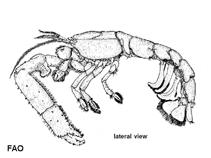| Family: |
Callianassidae (ghost shrimp) |
| Max. size: |
|
| Environment: |
benthic; brackish; marine |
| Distribution: |
Eastern Pacific. Climate: subtropical to temperate. |
| Diagnosis: |
Rostrum a low median angle on the anterior margin of the carapace. Eyes elongate triangularly pointed, reaching with their full length beyond the rostrum. Antennal angles blunt, without spine. Antennal peduncle practically as long as the antennular peduncle. Third maxilliped with merus and ischium strongly expanded forming operculum; the last three segments of the maxilliped less than half as wide as the merus, but not very slender, twice less than twice as long as wide. Large chela of adult male with the concave part of the anterior margin of the part above the base of the fixed finger absent or hardly noticeable. Carpus distinctly longer than palm. Merus with a large and rather wode hook-shaped process in the basal part of the lower margin; in the female this process is reduced to a small triangular tooth. Telson quadrangular, longer than wide and slightly narrowing posteriorly; posterolateral angles rounded. Posterior margin with a small triangular median denticle; no other spines or teeth on telson. Endopod of uropod broad, quadrangular or slightly triangular, with rounded angles and slightly longer than telson (Ref. 4). |
| Biology: |
Assumed total body length is 12.5 to 15 cm. Habitat: In lower intertidal zone of tidal flats on the sea coast and in estuaries. Behavior: It burrows in soft substrate of sand and mud (Ref. 4). |
| IUCN Red List Status: |
Not Evaluated (N.E.) Ref. 123251)
|
| Threat to humans: |
|
| Country info: |
|
Source and more info: www.sealifebase.org. For personal, classroom, and other internal use only. Not for publication.

